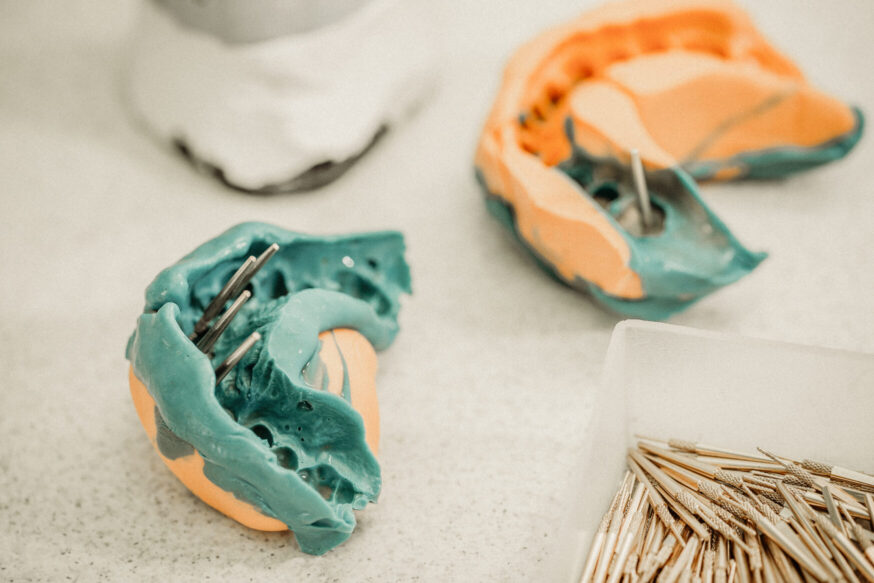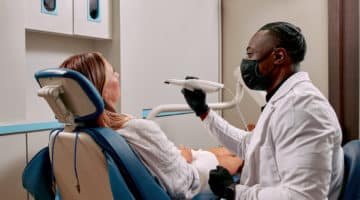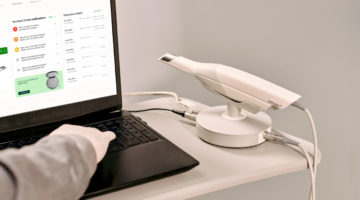Advancement in dentistry has brought rise to several renowned dental procedures beneficial to everyone. At the heart of these successful procedures lies one of the critical elements in dentistry: dental impressions, which play a pivotal role in creating precise replicas of a patient’s oral structures either with materials (analog/traditional) or now, digitally.
Dental impression materials are used to create an imprint of the teeth and surrounding oral structures by creating a dental impression poured with dental plaster to fabricate a dental cast. Each impression type and material has a distinct purpose. For instance, preliminary impressions are used to understand the patient’s teeth. It is necessary to determine an appropriate dental treatment plan for the patient. The other types are final impressions and bite registration impressions.
Dental professionals either select the appropriate impression material based on the specific clinical needs and patient requirements, or utilize the more patient-friendly and highly accurate intraoral scanner to make a digital impression.
Impression compound
Long before the introduction of impression compounds, creating accurate dental impressions was a major challenge for dentists. Materials like plaster of Paris and wax were used—but they needed to be improved for ease of use and accuracy.
This led dental practitioners to experiment with various materials to find a more practical solution for taking impressions of the oral cavity in the mid-1800s, leading to the development of impression compound. The early impression compound was often made from a mixture of natural waxes, resins (e.g., wax), fillers (e.g., talc or soapstone), and lubricants (stearic acid or stearin).
The impression compound gained popularity over time due to their simplicity and versatility. Dental practitioners discovered that the materials could be softened by heating, then molded to capture impressions of oral tissues, making them particularly useful for edentulous (toothless) patients and creating custom trays. Over time, manufacturers refined the composition of impression compounds, making them more consistent and predictable in their behavior when heated and cooled. This led to improved ease of use and reliability.
This is one of the oldest dental impression materials. It is a rigid, reversible impression material set by physical change. It is usually used for taking primary impressions of the edentulous ridge prior to the construction of a custom-made impression tray for complete dentures. Impression compound is also available in sticks of various colors, indicating different softening temperature ranges, e.g. greenstick compound (composition); these are used for impression correction and moulding the borders of custom impression trays, particularly around muscle attachments.
Application of impression compound
Impression compound can be used:
- For making a preliminary impression in edentulous arches.
- In custom tray construction for taking more accurate secondary impressions with elastomeric materials like silicones or polyethers.
- To create temporary restorations when a more precise and permanent restoration is not immediately available or possible.
- To create diagnostic models that offer a general overview of the patient’s oral structures. These models can help in treatment planning and communication with the patient.
- For the impression of full crown preparation, gingival tissues must be displaced.
- To check undercuts in inlay preparation.
- To create a basic outline of the patient’s oral anatomy, which can help create custom trays or preliminary models for diagnostic purposes.
Classification of impression compound
Impression materials can be classified into two main types:
- Type I – Impression compound
- Type II- Tray compound
Type I – Impression compound
Type I compounds, often called “greenstick compound” due to their characteristic green color, are used primarily for edentulous patients to record the anatomy of the alveolar ridge and surrounding tissues. It is a thermoplastic material that becomes soft and pliable when heated and rigid when cooled.
It is typically supplied in the form of sticks or sheets that need to be softened in a water bath or a special impression compound heater. After softening, the compound is placed in a tray or directly in the patient’s mouth to capture the impression. Although reusable, it cannot be sterilized and tends to become unhygienic and should not be reused ideally. It is nontoxic and nonirritant to the tissues.
Type II – Tray compound
Type II impression compound is also a thermoplastic material, but it is specifically designed for making custom impression trays. It is supplied in a form that is typically softer than Type I and in the shape of a tray (the custom tray for preliminary impression) that will later hold a second impression material, which will record the final impression (secondary impression).
Best of all, it is easier to manipulate. Dentists use it to create a custom impression tray that conforms precisely to the patient’s oral anatomy. Once the tray compound sets and hardens, it provides a stable and accurate platform for taking impressions with other materials, such as alginate or silicone. The resulting custom tray ensures a more comfortable and accurate impression of the patient’s teeth and oral structures.
The main difference between the two impression compounds is Type I is used for capturing preliminary impressions of the edentulous mouth. In contrast, the Type II tray compound is employed to create custom impression trays for accurate impressions of a patient’s dentition and oral structures. However, both impression compounds are essential tools that allow dentists to obtain accurate impressions for dental procedures, such as orthodontic treatments, denture fabrication, and crown and bridge work, and so much more.
Composition of impression compound
A sample of impression compound comprises of:
- Natural or synthetic resin
- Waxes (Bee’s wax, carnauba wax, Paraffin wax)
- Stearic acid, shellac, and gutta-percha
- Inorganic fillers/pigments
VPS impression material
Vinyl Polysiloxane Impression Material (VPS) is a type of hydrophilic material used to create precise and detailed moulds or impressions of a patient’s teeth, gums, and oral tissues. It is also known as Polyvinyl Siloxane (PVS) impression material, and it enables better-fitting restorations. It is mainly used due to its excellent accuracy, ease of use, and patient comfort.
VPS gained attention in dentistry in the mid-20th century due to improved accuracy and dimensional stability compared to earlier options as a result of extensive research and innovation in polymer chemistry. It showed exceptional accuracy in capturing fine details of the oral structures, making them suitable for a wide range of dental procedures and easy to use. The materials have low polymerization shrinkage, low creep, good dimensional stability, and surface detail reproduction.
VPS became widespread because it exhibited minimal distortion over time, ensuring the captured details remained accurate. The materials were user-friendly, too, both for the dentists and patients. PVS impressions demonstrated superior dimensional stability compared to earlier impression materials, primarily because it had improved taste and odor and did not release any by-product.
It is considered one of the traditional impression materials. Even today, it continues to play a role in some dentistry, ensuring precise restorations and prosthetic work albeit in a cumbersome procedure vs the ease of digital dentistry.
Application of VPS impression material
VPS impression material is a versatile and accurate analog material used in various dental applications such as:
- Capturing precise impressions for the fabrication of crowns, bridges, inlays, and onlays.
- Creating study models for orthodontic diagnosis and treatment planning to assess the patient’s bite, tooth alignment, and treatment progress.
- Capturing occlusal records for analysing jaw movements and TMJ function.
- Creating diagnostic models for dental procedures, treatment planning, and patient communication.
- Taking impressions of dental implant sites and the surrounding tissues for the purpose of enabling the fabrication of accurate implant restorations.
Classification of VPS impression material
VPS impression material is often classified based on its setting mechanism. Dentistry has the:
Addition-cured
This is the most commonly used VPS impression material. It polymerizes by the addition of components without the release of byproducts, making it highly stable and accurate.
Condensation-cured
As the name implies, it sets through a condensation reaction and may release some byproducts. It offers good accuracy but is less dimensionally stable than addition-cured VPS, which makes it the less commonly used VPS impression.
Composition of VPS impression material
VPS impression material typically includes:
- Inorganic fillers, such as silica or quartz
- Base Paste, containing vinyl-terminated polysiloxane polymer chains and a platinum catalyst
- Modifiers or additives to enhance characteristics like tear strength and setting time
- Catalyst paste to initiate the polymerization process when mixed with the base paste
VPS impression materials are preferred for a wide range of dental impressions due to their unique chemistry, allowing for excellent detail reproduction, minimal distortion upon setting, and high dimensional stability.
Alginate impression material
Alginate is an elastic, irreversible hydrocolloid impression material. It is a dental impression material known for its simplicity, cost-effectiveness, and ease of use in capturing preliminary impressions of patients’ oral structures and tissues. It is one of the most frequently used dental materials.
It is primarily made of seaweed-derived alginate powder mixed with water, making it a convenient choice for various dental applications and suitable for pediatric dentistry, provisional restorations, mouthguards, and creating diagnostic models. For many years, alginate impression material has been a staple of most dental practices, more and more it is giving way to digital dental impressions in modern practices.
Application of alginate impression material
Alginate impression material is usually taken for the fabrication of study models. It can be used to:
- Capture the initial or preliminary impression of the patient’s dental arches
- Make whitening trays and other dental appliances
- Oftentimes, it is chosen for taking impressions of children’s teeth due to its quick setting time and ease of use
- Create provisional (temporary) restorations while the final restorations are being fabricated
- Some alginate impressions are used in the fabrication of mouthguards for sports or night guards for teeth grinding (bruxism) protection
Classification of alginate impression material
Alginate impression material falls into the category of hydrocolloid impression materials due to its water-based composition. Hydrocolloid impression materials are impression materials that form a viscous liquid that can be seated over an oral structure. At first, the liquid sets before becoming a gelatin-like solid, one flexible enough to be drawn over undercuts without significant permanent deformation.
Now, within the hydrocolloid category, alginate can be classified as an irreversible hydrocolloid. This is because it undergoes a chemical reaction during the setting process and cannot be reused once it has been set.
In dental practice, alginate is a valuable tool for capturing preliminary impressions and creating a base for diagnosis and treatment. It also provides a foundation for constructing custom trays for more accurate final impression.
Composition of alginate impression material
The primary component of alginate impression material is derived from seaweed (algae) and is typically mixed with water to create a viscous paste. The alginate powder mixed with water usually contains roughly 15% potassium or sodium alginate, 16% calcium sulphate dehydrate, 4% zinc oxide, 3% potassium titanium fluoride, and 2% trisodium phosphate.
It also contains coloring, flavoring agents, and fillers like diatomaceous earth to control the material’s setting time and improve its physical properties.
Polysulfides impression material
This dental impression material has been used in dentistry for several decades. It is known for its unique properties and applications in capturing precise impressions of a patient’s teeth and oral structures.
Dentists began using Polysulfides, also known as Rubber Base, an elastic material made of synthetic rubber renowned for its bad smell and taste, in the mid-1950s. It was developed to address the need for a more convenient, accurate and stable material for dental impressions. It is incredibly effective for making full-arch impressions, which makes it one reason many dentists have used polysulfide for their impressions before the intraoral scanner came into common use.
The polysulfide materials are supplied as two pastes, with one tube labelled catalyst or accelerator and the other marked as a base.
Application of polysulfides impression material
- It is used for partial denture impressions, where accurate impressions of the edentulous areas and adjacent teeth are critical.
- It helps orthodontists assess the patient’s bite and tooth alignment by creating study models for diagnosis.
- It can be used to create precise models that serve as the basis for designing and fabricating various prosthetic appliances.
Classification of polysulfides impression material
Depending on how easily they flow under load, they are classified as:
- Low viscosity-light bodied
- Medium viscosity
- Heavy viscosity or putty
Composition of polysulfides impression material
The components of polysulfide impression material allow it to exhibit good accuracy, stability, and tear resistance—making it suitable for a range of dental impression applications. It contains:
- Sulfur atoms in the molecular structure which is the primary component. It is typically mixed with other components, including accelerators and fillers.
- Accelerators are chemical compounds that facilitate the setting or curing process. They initiate the cross-linking reactions within the polymer, leading to the material’s solidification.
- Usually, inorganic fillers are often added to the material to control its viscosity, improve handling characteristics, and modify properties such as tear strength.
- Plasticizers are additives sometimes incorporated into the formulation to enhance the material’s flexibility and ease of manipulation. This helps prevent the impression material from becoming too rigid when set.
Ditching impression materials for digital impressions
One amazing factor in the progressive evolution of impression materials is the use of new dental technologies in all aspects of dentistry, including diagnosis, treatment planning, and restoration, encompassing a range of technologies.
Digital dentistry came about to improve the discomfort, errors, time consumption, and several other effects the traditional methods had on patients. This technology allowed for more accurate and detailed teeth and jaw imaging and helped improve diagnosis and treatment planning. In the 1980s, the first CAD/CAM technology system was introduced for dental restorations, allowing the computer-aided design of dental restorations, which could then be milled out of a block of material using a CAM system.
Digital impression systems typically consist of a handheld intraoral scanner, which began to first gain steam in the late 1990s and early 2000s and are ubiquitous today. These handheld devices use light or dental laser technology to capture precise 3D images of a patient’s oral cavity. The captured data is then processed by specialized software to create digital models, eliminating the need for physical impressions.
This new technology has increased patient comfort, reduced chair time, and improved accuracy, while being easy for the doctor or dental staffer to use. The elimination of physical molds also reduces the risk of contamination and distortion. Digital impressions are also more eco-friendly, as they reduce the need for disposable impression materials and trays. They are more efficient in dental procedures such as dental implants, fabrication of restorations like crowns and bridge work, inlays and onlays, as well as the planning and placement of orthodontic appliances.
Digital impressions have enhanced dentistry in so many ways. It has become an integral part of modern dental practice and introduced a more comfortable, efficient, and accurate way to capture and work with dental impressions, benefiting both dentists and patients. It has become an integral part of modern dental practice.
Make better impressions, digitally, with Dandy
Dandy is the only dental lab in the United States that only accepts digital impressions. Ditching the traditional impression materials and going digital saves practices time and money and increases your practice reputation by creating a better patient experience. In fact, practices that use intraoral scanning are 12% more likely to be referred by their patients, according to the Dandy Dental Study: Patient Experience. Ready to see what the digital hype is all about? Reach out to our team to claim your free intraoral scanner and get started.



